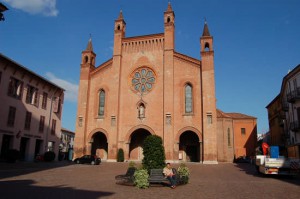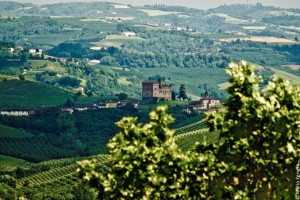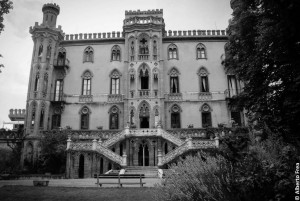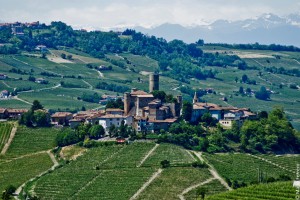Alba and Langhe: Medieval Itineraries
Alba is a centre of great art and historical relevance and is commonly known as “the Langhe capital”.
This importance is connected to its ancient origins: recent archaeological research has confirmed that Alba Pompeia was one of the main inhabited centres during the Roman age in southern Piedmont. Between 2007 and 2011 the archaeological digs have allowed us to identify the Alba forum in the area located among Saint Lawrence Cathedral, Piazza Risorgimento and Piazza Pertinace, thanks to the finding of the pagan temple under Palazzo Marro.
 Among the most representative monuments of the historical centre, we find the Saint Lawrence Cathedral: a visit to the underground museum and the current religious site, allows us to discover the city’s ancient past related to the Roman era, the medieval era, the renovations made by Bishop Andrea Novelli between the 15th and the 16th century until the final neo-Gothic reshufflings at the end of the 19th century. The combination of different architectural styles make the building particularly interesting and the presence of the 12th century bell tower is an amazing element which becomes even more surprising if one has the opportunity to visit the particular structure of the “double bell tower” which hosts the second Romanesque tower dating back to the end of the 10th century. It is still possible to see few elements of the Romanesque Cathedral, among which the precious gates made from sandstone rock, which welcomes believers and visitors, and the pavement made with layers of rock on which the polygonal-shaped entrance stairs, dating back to the end of the 12th century, lay.
Among the most representative monuments of the historical centre, we find the Saint Lawrence Cathedral: a visit to the underground museum and the current religious site, allows us to discover the city’s ancient past related to the Roman era, the medieval era, the renovations made by Bishop Andrea Novelli between the 15th and the 16th century until the final neo-Gothic reshufflings at the end of the 19th century. The combination of different architectural styles make the building particularly interesting and the presence of the 12th century bell tower is an amazing element which becomes even more surprising if one has the opportunity to visit the particular structure of the “double bell tower” which hosts the second Romanesque tower dating back to the end of the 10th century. It is still possible to see few elements of the Romanesque Cathedral, among which the precious gates made from sandstone rock, which welcomes believers and visitors, and the pavement made with layers of rock on which the polygonal-shaped entrance stairs, dating back to the end of the 12th century, lay.
The skyline of the city of Alba is characterized with medieval towers: Sineo tower, Astesiano tower, Parussa tower, Bonino tower, and so on. Today, it is possible to admire ten of them, three still well preserved with all their verticality overlook Via Vittorio Emanuele II, Via Cavour and Piazza Risorgimento. Despite Alba being known as the “one hundred towers city”, it is quite unlikely that there were so many; maybe about forty were built in order to represent the power of the noble families, to protect the city and be used as places to store agricultural products.
From
Alba’s historical centre, by car, within minutes it is possible to reach the gentle slopes of Langhe, and after reaching the suburban area of San Cassiano, you can notice a majestic building: the ancient Abbey of Saint Frontiniano. Here, in fact, the martyr Frontiniano was beheaded on 23rd October 311 A.D. and in the 9th century, the Benedictine monks of Bobbio established an important religious centre where, until the 15th century, his relics were kept. It is still possible to see the tower from the ancient abbey.
From a distance, the castle Grinzane Cavour, with is tremendous architectural structure reminiscent of a dungeon, stands out surrounded by precious Nebbiolo vineyards. The castle is one of the most renowned landmarks of Langhe and is part of one of the most evocative places of this territory, recognized by UNESCO as a World Heritage site with its landscape dotted with vineyards. The origins of the buildings date back to the first half of the 11th century: the big central tower was part of the original core of the building. In the 13th and 14th century, the castle was then expanded by adding new wings which make the current structure impressive as well as graceful and uniform. In the 15th century, this historical residence belonged to the Marquises of Busca, and after became the property of other important families among which the Dukes Clermont-De Tonnerre, uncles of Camillo Benso, Count of Cavour, statesman of the Risorgimento period, who was mayor of the village from 1832 to 1849. In the Langhe area, Cavour started the first tests to improve the production of Piemdontese red wines and refine the aging techniques which went on to create the famous Barolo wine. In the territory of the Barolo Langa, the village of La Morra is one of the most famous and visited by tourists looking to appreciate the lovely panoramic square and the network of routes that allow them to wander among vineyards, where the Barolo wine grapes are cultivated, and reach other small centres of the Langhe region. Right after the current centre, it is possible to reach the Annunziata hamlet, the first residential area of La Morra, which still preserves the Romanesque-Baroque complex built from the former Benedictine convent which dates back to the 12th-13th century and from the Church of Saint Martin of Mercenasco, built in the 15th century with parts renovated in the 17th century. The bell tower, made of rock, is characterized with single-light windows and three-light windows.
In the Langhe area, Cavour started the first tests to improve the production of Piemdontese red wines and refine the aging techniques which went on to create the famous Barolo wine. In the territory of the Barolo Langa, the village of La Morra is one of the most famous and visited by tourists looking to appreciate the lovely panoramic square and the network of routes that allow them to wander among vineyards, where the Barolo wine grapes are cultivated, and reach other small centres of the Langhe region. Right after the current centre, it is possible to reach the Annunziata hamlet, the first residential area of La Morra, which still preserves the Romanesque-Baroque complex built from the former Benedictine convent which dates back to the 12th-13th century and from the Church of Saint Martin of Mercenasco, built in the 15th century with parts renovated in the 17th century. The bell tower, made of rock, is characterized with single-light windows and three-light windows.
From here, it is possible to reach, on foot, one of the most renowned natural monuments of Langhe: the Cedar of Lebanon on the Monfalletto hill. This panoramic and romantic spot is related to the year 1856, when the cedar was planted in memory of the wedding between Costanzo Falletti of Rodello and Eulalia Della Chiesa of Cervignasco.
Now continue towards Novello, where the Del Carretto family built, on a cliff, a dungeon which unfortunately was destroyed by the Spanish in 1437. From the medieval era, it is still possible to spot, at the entrance of the historical centre, a big squared tower with an archway, originally built on the western side of the hill to protect the manor, which has since been replaced by a castle with nineteen-century architecture designed by the architect G. B. Schellino of Dogliani.
The itinerary continues on into the area called Alta Langa. Here we can find the village of Roddino, located on the edges of the south-western Langa, 610 metres above sea level. In the 10th century, a majestic watchtower was erected and after, thanks to that privileged position, a defensive castle was built, around which, an inhabited area developed. In the early Middle Ages, the castle became property of the Alba council, then of the Marquisate of Vasto and in the 12th century it became domain of Boniface the Great first, and then, from 1197, of the Marquisate of Saluzzo. In the middle of the 1600s, during the civil wars between the Savoy family and the Marquisate of Saluzzo for control of the territory, the castle of Roddino was completely destroyed. Visiting the centre of the village, you can imagine it with its powerful structure where the parish church of Saint Margaret stands today.
The ancient building dates back to the 12th century and still keeps some Romanesque traits in the small apsis made from sandstone rock. The church was built near the castle of the Marquises of Saluzzo, first as an oratory, but then it turned into a parish church at the beginning of the 15th century. Some parts of the side walls and the basin of holy water, dating back to 1499, can be admired in the sacristy. A few kilometres from the centre of the village, in the direction of Cerretto Langhe, you will find a place with a curious name: Pedaggera. The name recalls the ancient function of passage in a place of boundaries between different Marquisates: here the goods in transit were subject to a payment of a duty or a toll, “pedaggio” in Italian.
As a last stop of this medieval stroll in the Langhe, we suggest you visit Castiglione Falletto where a castle and its majestic rounded towers dominate the surroundings. The castle was built, in 1225, by Bertoldo Falletti, who received the property from the Marquises of Saluzzo in return for military favours. During the centuries, Castiglione was ruled by several noble families: the Falletti owned the fortress until the end of the 17th century and wanted to add their name to that of the village, which became Castiglione Falletto. The property was then owned by the families Caramelli, Clarotto and Vassallo of Dogliani who made, each one in their own period, restoration works until transforming the fortress into a noble residence. Nowadays, the centre of Castiglione Falletto enchants us with its majestic circular shape towers, the central great tower and the bastions reminiscent of the Middle Ages, battles fought on these hills, during the centuries, by horsemen and soldiers of the noble families aiming at protecting this territory. Today, the castle is a private property but still preserves inside two floors, a great central hall and rooms decorated with fireplaces and frescos.
The castle was built, in 1225, by Bertoldo Falletti, who received the property from the Marquises of Saluzzo in return for military favours. During the centuries, Castiglione was ruled by several noble families: the Falletti owned the fortress until the end of the 17th century and wanted to add their name to that of the village, which became Castiglione Falletto. The property was then owned by the families Caramelli, Clarotto and Vassallo of Dogliani who made, each one in their own period, restoration works until transforming the fortress into a noble residence. Nowadays, the centre of Castiglione Falletto enchants us with its majestic circular shape towers, the central great tower and the bastions reminiscent of the Middle Ages, battles fought on these hills, during the centuries, by horsemen and soldiers of the noble families aiming at protecting this territory. Today, the castle is a private property but still preserves inside two floors, a great central hall and rooms decorated with fireplaces and frescos.
Wine Cellars Along the Itinerary
Vietti
, Piazza Vittorio Veneto, 5, Castiglione Falletto CNLe Strette
, Via Le Strette, 1/F int.1, Novello CNGigi Rosso
, Strada Alba-Barolo, 34, Castiglione Falletto CNSordo Giovanni
, Via Alba-Barolo 175, Castiglione Falletto CNCrissante Alessandria
, Borgata Roggeri, 44, La Morra CNBoroli
, Via Brunella, 4, Castiglione Falletto CNTenuta L’Illuminata
, Località Sant'Anna 30, La Morra CNMauro Marengo
, Località San Grato 1, Novello CNStra Viticoltori with guesthouse
, Località Ciocchini, 5, Novello CNDosio Vigneti
, Regione Serradenari 6, La Morra CNPoderi Colla
, San Rocco Seno d’Elvio 82, Alba CNMauro Molino
, Frazione Annunziata Gancia 111A, La Morra CNAurelio Settimo
, Frazione Annunziata, 30, La Morra CNCiabot Berton
, Frazione Santa Maria 1, La Morra CNAgricola Gian Piero Marrone
, Frazione Annunziata 13, La Morra CNCasa Baricalino
, Località Baricalino 7, Novello CNBosco Pierangelo
, Borgata Boiolo, 1, La Morra CNMonchiero
, Via Alba - Monforte, 49, Castiglione Falletto CNEnoteca Regionale Piemontese Cavour
, Via Castello, 5, Grinzane Cavour CNMauro Sebaste
, Via Garibaldi, 222 bis • Frazione Gallo, Alba CNNegretti
, Frazione Santa Maria, 53, Località Peso, La Morra CNCascina Mucci
, Località Mucci, 2, Roddino CNTenuta Baràc
, Frazione San Rocco Seno D’Elvio 40, Alba CNTerre del Barolo
, Via Alba-Barolo, 8, Castiglione Falletto CNPlaces to Eat Along the Itinerary
Hotel Restaurant I Castelli
, C.so Torino 14, Alba CNAgricola Gian Piero Marrone
, Frazione Annunziata 13, La Morra CNAlessandro Mecca Restaurant at Grinzane Cavour Castle
, Via Castello 5, Grinzane Cavour CNAccommodation Along the Itinerary
Crissante Alessandria
, Borgata Roggeri, 44, La Morra CNHotel Langhe
, Strada Profonda, 21, Alba CNTenuta L’Illuminata
, Località Sant'Anna 30, La Morra CNStra Viticoltori with guesthouse
, Località Ciocchini, 5, Novello CNArborina Relais
, Frazione Annunziata 27/B, La Morra (CN)Dosio Vigneti
, Regione Serradenari 6, La Morra CNHotel Restaurant I Castelli
, C.so Torino 14, Alba CNCiabot Berton
, Frazione Santa Maria 1, La Morra CNCasa Baricalino
, Località Baricalino 7, Novello CNMauro Sebaste
, Via Garibaldi, 222 bis • Frazione Gallo, Alba CNTenuta Baràc
, Frazione San Rocco Seno D’Elvio 40, Alba CNPlaces to buy Food and Wine Products Along the Itinerary
Agrisalumeria Luiset – COLD CUTS
, piazza San Francesco, 5, Alba CNPaolo Bove – Food and cosmetics based on snail slime of the highest quality
, Loc. Bricco Neri 5, Novello CN




